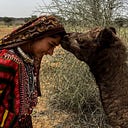Loss and Grief at 14000 ft
A Shepherd’s Fight to Save His Dying Flock
By CfP Field Researchers:
Abhinanda Lahiri, Vidur Datt, Amiya Walia
A golden sunset turned to night, as Rohit sat on a rock where network was sometimes available, and called everyone he could. “Please help us”, he repeated. By sunrise, twelve animals had succumbed at 14000 ft. We watched in horror as their keepers picked up the lifeless bodies on their backs, and buried them inside piles of rocks.
An intangible phenomenon of pastoral life is the entwinement of a pastoralist’s life force with that of their flock. On 29th June 2023, we witnessed the devastation caused by the PPR virus to a large flock of 1400 sheep and goats at their alpine pastures in Hadsar, Lahaul. This encounter revealed a narrative emerging from the inaccessibility of vaccines, medical aid, emergency relief, and basic knowledge of animal healthcare.
Peste des petits ruminants (PPR), a highly contagious and fatal viral disease for small ruminants, can wipe out almost a third of an unvaccinated flock. To combat PPR, the Government of India and the World Health Organisation have set 2030 as a target for its eradication. Fortunately, since 1987, India has had an effective indigenous vaccine that offers lifelong immunity against PPR. However, outbreaks continue to occur in several Indian states, with Himachal Pradesh experiencing the second-highest frequency of outbreaks between 1995–2019, as per national surveillance data. Recognising the significant ownership of sheep and goats by migratory pastoralists in HP, the Animal Husbandry Department (AHD) provides free access to vaccines.
This encounter painted a vivid portrait of the waning vitality of pastoralists as parallel to the health of their flock.
However, on interviewing pastoralists from Chamba, our team found that only 10 of 100 pastoralists had vaccinated their flock. Across other districts in HP, dozens of pastoralists spoke about how medicines, vaccines and veterinary care were difficult to access, particularly in remote locations.
This article stems from our interaction in Lohani, Lahaul, with Rohit, a 32-year-old Gaddi, whose young family lives in Chamba’s Churah tehsil. Every year, his dhera, composed of 5–6 pastoralists with 1400 sheep and goats, crosses over into Lahul via the Merowa pass, en route to their monsoon meadows in the remote Hadsar Dhar. This year, shortly after crossing into Lahaul, they were blindsided by a mysterious illness spreading through the flock. By the time we met Rohit, 200–300 of his animals could not walk, eat or see, and over 50 had died from what later revealed itself as PPR.
As we followed Rohit to the ridge, painful sounds of retching, and incessant groans came from all sides. Under massive pines, there were dozens of mostly adolescent goats with sore, bruised lesions on their nose-mouth, thick mucus falling out with each scurry breath, eyes sealed shut with a yellowing mucus, diarrhoea, and limited movement.
In a desperate effort to access medicines, Rohit made three trips down to Lohani, a 3-hour trek from his pasture, and then to the nearest veterinary centre in Udaipur, 22 km away. Each time, he returned with just 2–3 vials of medicines from the clinic, without as much as a diagnosis. He finally requested a friend in Killar (Pangi Valley), close to 50 km away, to send him a box of any medication he could find. Despite Lahaul’s 25 veterinary centres, it was in good-will alone that Rohit managed to get his first set of limited medical supplies from the secluded Pangi Valley.
Over many days, Rohit repeatedly tried reaching out for help — from Churah’s MLA, to the Lahaul AHD — all to no avail. He was finally able to contact veterinarians Dr Sachin Sood (in Kangra) and Dr Kishor Rana (in Sissu) who were quick in diagnosing PPR and sounded the alarm on the urgent requirement for aid. Once our team witnessed the situation of the flock at Rohit’s pasture in the Hadsar mountains, we returned to base and eventually reached out to local activists Pawana Kumari and Akshay Jasrotia of the Himachal Ghumantu Pashupalak Mahasabha (HGPM). We updated them on the situation and requested them to contact the AHD. Within just a few hours, a team of veterinarians arrived with medicines in bulk, along with a compelling official deployment notice from the AHD. When asked about the flock not being vaccinated, Rohit responded “No vaccines come for us. No medicines are given to us.”
By the time Rohit’s dhera received aid, about 80 animals had already died. This amounts to a loss of 8–10 lakh INR, which is an underestimation of actual losses suffered by a herder, since in addition to mortality, PPR is also associated with reproductive failure, reduced milk and wool production, inability to sell livestock for meat, and even diminished body weight in surviving animals.
Pastoralists graze their animals in isolated landscapes, often distant from urban centres, and in areas with poor road access. Under such conditions, pastoralists invariably experience difficulties in availing services such as vaccination and other medical care that we take for granted.
Losses such as these are extremely difficult to recover from and play a vital role in pastoralists’ decisions to sedentarise. However, such mammoth losses are avoidable, in this case through the simple preventative measure of PPR vaccinations being made available to all pastoralists. Today we have access to products such as milk, meat, wool and leather due to pastoralists like Rohit. And, they are the ones most in need of responsive veterinary care to safeguard their livelihoods.
The sheer quantum of migratory sheep and goats reaching the districts of Lahaul-Spiti from Chamba demands an allocation of sufficient vaccinations, medicines and veterinary teams in both districts for the duration of the summer and monsoon seasons. While this encounter provided a picture of what an effective state response can look like, it was also a window into a pastoralist nightmare which could be avoided with better planning. Where pastoralists go, medical care should follow.
